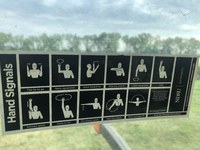Keep Safety in Mind During Fall Harvest
Now is a good time to be thinking about farm safety.
(Click the image below to view a high-resolution image that can be downloaded)
As we begin harvesting, now is a good time to keep general farm safety in mind, according to Katelyn Landeis, North Dakota State University Extension’s agriculture and natural resources agent in Grand Forks County.
Here are some tips:
- Wear ear protection. For example, grain augers, grain vacs, grain dryers and tractors with no cab are rated at about 82 to 100 decibels. Being exposed to 100 decibels for just 15 minutes can cause damage to hearing. Eight hours at 85 decibels also can damage hearing. Check out a brochure (https://tinyurl.com/ProtectingYourEars) by the Centers for Disease Control and Prevention and National Institute for Occupational Safety and Health for more information on protecting your ears. Be even more careful to protect the ears of children. Hearing damage is irreversible.
- Shut off equipment when needing to do maintenance. Leaving equipment running is not worth risking your life or a limb. Read a producer testimonial on the North Dakota State University Extension Farm Safety website at www.ag.ndsu.edu/extension/farmsafety.
- Chances are, you are sharing the road with individuals who are not familiar with driving farm equipment or semitrucks. Be mindful of their safety and your own as you travel on public roads. Rick Schmidt, an NDSU Extension agent in Oliver County, has created a series of short videos addressing road safety. They are available on the NDSU Extension Farm Safety website.
- Always be equipped with proper personal protective equipment (PPE). Wear the right mask for the right task.
- If you have youth working on your farm, make sure they are doing age-appropriate tasks. Keep youth away from chemicals/pesticides and out of grain bins with grain.
- Learn the same language. To enhance communication and promote farm safety, the American Society of Agriculture and Biological Engineers developed 11 universal hand signals. NDSU Extension has released a poster and window cling to help you learn those signals.
- Always make sure workers are trained before they hop onto equipment they haven’t run before and take time to become familiar with equipment you have not operated for a while.
- Talk about safety with your family and others with whom you work. Make sure everyone knows safety is a priority. Have a safety plan in place in case an accident occurs. Marshfield Clinic has an interactive mapping program (https://www.marshfieldresearch.org/nfmc/farm-mapper) to help farm operators identify where hazards are on their operation. Identifying where the hazards are on your farm allows emergency responders to prepare for the scene and know their surroundings.
- Practice good hygiene and physical distancing, and encourage everyone to wear face masks when appropriate because we still are in the midst of a pandemic.
Check out the Upper Midwest Agricultural Safety and Health Center (http://umash.umn.edu/about-the-center) and NDSU Extension Farm Safety web pages for more resources.
NDSU Agriculture Communication - Sept. 3, 2020
| Source: | Katelyn Landeis, 701-780-8229, katelyn.hain@ndsu.edu |
|---|---|
| Editor: | Ellen Crawford, 701-231-5391, ellen.crawford@ndsu.edu |


